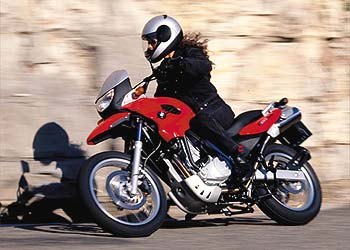First Look: BMW F 650 GS - Motorcycle.com
A Revised Edition of the Best Motorcycle Americans Don't Buy
While the F 650 is a recent addition to BMW's line-up, the German marque has a long history of producing single-cylinder powered motorcycles. Starting in 1925 with the R39 model all the way to the R27 in 1966, BMW produced more than 230,000 single-cylinder motorcycles.
In 1993, 27 years later, BMW decided to put a new single on the market. The Rotax engine was the same as the unit used in Aprilia's 650 Pegaso -- a mono-cylinder four-stroke (the difference between the two engines is the cylinder-head: five valves for the Aprilia, four valves for the BMW). The bike was a hit in Europe and in only six years BMW has produced over 64,000 units. Impressive.
BMW F 650s used to be built by Aprilia in Noale, Italy to BMW specifications. Now, for the year 2000, BMW has decided to build the 650 in Berlin in a new workshop beside the original BMW factory. Were there problems with Aprilia? It's hard to say, but it is also no secret that German manufacturing methods are different than Italian methods.
By the way, if you have ever wondered about the surname GS, in German it stands for Gelande Strasse, which, in English, means Trail and Street.
The new F 650 GS has a new engine developed by BMW and Rotax and is different from the original Aprilia powerplant. The new engine shares with the former only the five-speed gearbox, the crankshaft and the anti-vibration shaft. Everything else is new. The engine itself is entirely built by Rotax in Gunskirchen, Austria, except for the pair of camshafts that are built by BMW. After initial assembly, the engines are transported to Berlin where BMW completes the 650 GS.
The most signification innovation of the new four-valve, DOHC, liquid-cooled engine is incorporation of a electronic fuel injection system developed by Bosch and BMW. The previous F 650 used a pair of 33mm Mikuni carburetors.
Also, the cylinder head was designed by the car development department that built the BMW M3. Due to environmental regulations, the exhaust features a catalyst system that fits into a pair of under-the-seat silencers. This engine offers 50 hp at 6,500 rpm and 43.4 ft-lbs at 5000 rpm (6 kg/m @ 5000)
The frame is basically the same as the old F 650: a twin-spar frame with a re-enforcing frontal tube made of iron alloy. The wheelbase is 1479mm (58.2 in), 1mm less than the 1999 version.
The front suspension is equipped with 43mm Showa forks featuring 170mm of travel and a rear monoshock with 165mm of travel. The 650 GS is shod with a 100/90 x 19 front tire and a 130/80 x 17 rear, the same sizes as last year's model.
The brakes are the same size as last year's as well with a 300mm single front rotor bit by a two-piston Brembo brake caliper. At the rear resides a 240mm single rotor with a single-piston Brembo brake caliper. This bike can be equipped with BMW's ABS system, should you chose.
The new F 650 GS offers quite a few upgrades and tweaks.
For example, the 17.3 liter (4.6 U.S. gal) fuel tank is found under the pilot's seat and the fuel tank cap is placed on the right side under the pillion seat. Beneath the faux fuel tank is the battery and the oil and coolant reservoirs. The instrument panel is also new, with an improved design that is far more attractive than the earlier version. Two different sized gauges house the speedometer and the tachometer. Placed between these are the standard collection of indicators. In addition BMW offers a large assortment of accessories for the F 650 GS such as a top case, side bags, heated grips, ABS, hand protectors and a travel computer.
In honor of their recent domination of the Paris-Dakar rallies, BMW has also built a specialized version of the 650 GS -- the Dakar. The differences lies in the Dakar's long-travel suspension of 210mm in the fork, the new color scheme and the Dakar logo.
A 21-inch front wheel is also used, and at 870mm (34.25 in.), the seat height is taller. A larger wind screen is mounted to a slightly different frame that creates a longer wheelbase. Unfortunately the Dakar has two handicaps: no center stand and no ABS.
Personally, I think that this bike might be one of the best styled BMWs ever built. The lines are beautiful and the design, for a BMW, is unique. Thus the F 650, one of the best thumpers made, is now even better. Unfortunately, this beautiful and practical bike will probably sell slowly in the States since the market for high-quality enduro styled road bikes is not very large. It's a shame, really. Still, BMW designed the F 650 GS with Europe in mind and what the American don't get the Europeans understand. And BMW is just fine with that.
Specifications
Manufacturer: BMWModel: F 650 GS
Engine: Single-cylinder, Water-cooled, 4-valve, DOHC, 4-stroke
Bore x stroke: 100 x 83 mm
Displacement: 652 cc
Carburetion: EFI Bosch-BMW
Transmission: 5-speed
Claimed power: 50 hp at 6x.500 rpm
Claimed torque: 43 ft-lbs at 5000 rpm (6 kgm at 5.000 rpm)
Wheelbase: 58.3 in.i (479 mm) (58,6 in/1489mm for the Dakar)
Rear Tire: 100/90 - 17 Tubeless Radial
Front Tire: 130/80 - 19 Tubeless Radial (90/90 x 21 for the Dakar)
Fuel Capacity: 4,57 gal. (17.3 L)
Claimed Dry Weight: 388 lbs (176kg) (385.8 lbs/175kg for the Dakar)
Color Schemes: Titan Blue, Red and Mandarin Yellow
More by Antonio Regidor


































Comments
Join the conversation